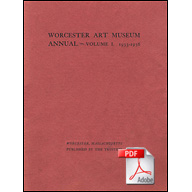-
- Format
- Journal Article
-
- Language
- ENGLISH
-
- Year Published
- 1936
-
- Number of Pages
- 3
-
- Citation Text
- Cott, Perry Blythe. "An Egyptian Sculpture of the Fourth Dynasty." Worcester Art Museum Annual I (1935-36), pp. 16-18.
-
- Individual - Ancient
- Hetepheres II (G 7110-7120)
- Menkaure
- Meresankh III (G 7530-7540)
-
- Author
- Perry Blythe Cott
-
- Publisher
- Worcester Art Museum
-
Greywacke pair statue of Menkaure and Queen
- MFAB_11.1738
-
Reproduction of greywacke pair statue of Menkaure and Queen
- EMC_SR_2/15815
-
- WAM_1934.48
Ancient People
-
- Type Individual - Ancient
- Remarks Original owner of G 7110, along with Kawab (owner of G 7120). Appears with her daughter Meresankh III in G 7530-7540 (east and west walls, main room), and in pair statue MFA 30.1456 (= 27-4-963 + 27-4-964 + 27-4-965). Later married to a king, possibly Djedefre (Radjedef) according to Reisner, but Khafre is also a possibility. Her association with G 7350, and its sarcophagus is uncertain. Also mentioned in tomb of her steward Khemetnu (owner of G 5210).
-
- Type Individual - Ancient
- Remarks Fifth king of Dynasty 4. Son of Khafre. Husband of Khamerernebti II. Builder of the Third Pyramid at Giza. Known two thousand years later by the Greeks as King Mycerinus.
-
- Type Individual - Ancient
- Remarks Owner of G 7530-7540.Granddaughter of King Khufu, builder of the Great Pyramid, and wife of either Khafre or Menkaure. Her unique underground chapel (labeled G 7530-7540) preserves beautifully carved and painted scenes of the queen and her royal family, as well as servants, artisans, and funerary priests. The scenes also depict the sort of rich burial goods that would have been placed in Meresankh’s tomb: statues and fine furniture; boxes containing food, clothing, and jewelry; even a representation of the black granite sarcophagus that was actually found in situ in her burial chamber. Chapel entrance architrave, jambs, reveals and drum inscribed for Meresankh, idenitifed as [mAAt Hr stX wrt Hts nbwj xt Hr wrt Hst DHwtj smrt Hr mrt=f sAt nswt n Xt=f Hmt nswt mrt] seer of Horus and Seth, great one of the hetes-scepter of the Two Lords, khet-priestess of Horus, great of praises of Thoth, companion of Horus, his beloved, king's daughter of his body, beloved king's wife; in situ in G 7530-7540. Appears in chapel relief of main room: seated holding lotus (south wall); standing with her mother (east wall), idenitifed as [wrt Hts] great one of the hetes-scepter; on pillars (north wall), idenitifed as [tjst Hr] intimate(?) of Horus; seated at offering table, standing north of false door and on central pillar, and with her mother and son (west wall), idenitifed as [Hm-nTr DHwtj wrt Hts nbtj Hm-nTr bApf Hm-nTr HwtHr nbt jwnt smAwt mrjj nbtj] priestess of Thoth, great one of the hetes-scepter of the Two Ladies, priestess of Bapef, priestess of Hathor Mistress-of-Dendera, consort of him who is beloved of the Two Ladies; in situ in G 7530-7540. Also appears on all walls of offering (west) room; in situ in G 7530-7540. Architrave on north wall of north room inscribed for Meresankh; uninscribed statues may also represent Meresankh (along with other female family members); in situ in G 7530-7540. Black granite sarcophagus (Cairo JE 54935) inscribed for Meresankh, idenitifed as [xrp sSmtjw SnDt] director of butchers of the 'Acacia House'; in situ in burial chamber of G 7530-7540. Incomplete limestone statue of Meresankh (MFA 30.1457) and pair statue of Meresankh and Hetepheres II (MFA 30.1456); found displaced in debris of main room. Mother ([mwt=f] his mother) of Nebemakhet (owner of G 8172 = Lepsius 86). Appears in relief of inner chapel (above doorway in eastern wall), identified as [mAAt Hr stX wrt Hts wrt Hst Hmt nswt] seer of Horus and Seth, great one of the hetes-scepter, great of praises, king's wife; in situ in G 8172. Also mentioned in the tomb of her steward Khemetnu (owner of G 5210).
Modern People
-
- Type Author
- Nationality & Dates
-
- Type Publisher
Name of this image
Description of the image duis mollis, est non commodo luctus, nisi erat porttitor ligula, eget lacinia odio sem nec elit. Sed posuere consectetur est at lobortis. Donec sed odio dui.

Sign up for My Giza | Log in
Email ‘My Latest Project’ Collection
Current Collaborators
- Heather ONeill heather@pixelsforhumans.com
- Nicholas Picardo npicardo@fas.harvard.edu
- Luke Hollis luke@archimedes.digital

